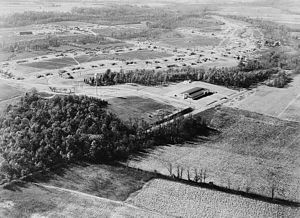Roosevelt, New Jersey
Roosevelt, New Jersey is a rural town in central New Jersey with a slowly declining population of less than 1000 people. The town grew from an experimental immigrant community in the 1930’s to a present-day artist colony.[1] The borough was created with the name "Jersey Homesteads" by an act of the NJ Legislature in 1937 from portions of Millstone Township and was renamed to Roosevelt in 1945 after the death of President Franklin D. Roosevelt. It was created during the Great Depression as part of President Roosevelt's New Deal, its main purpose being to resettle Jewish garment workers who wanted to escape from New York City to the countryside and operate a cooperatively-owned garment business. The business did not succeed, but afterward, the town attracted people active in the arts, civil rights, economic equality, immigration, and labor issues.
The original houses in the town were built under the auspices of the New Deal's Resettlement Administration. Designed by architect Alfred Kastner and his assistant Louis Kahn, each house was a flat-roofed building situated on a half-acre lot adjoining communal green space and woods.
History


The town was conceived originally as an integrated cooperative project, with farming, manufacturing, and retail all on a cooperative basis.[2] Farmland in Central Jersey was purchased by Jersey Homesteads, Inc., a corporation owned by the federal government but under control of a board of directors selected by Brown. Construction started around 1936. Soon after there were 200 homes and various public facilities in place. The economy of the town consisted of a garment factory and a farm.[3] Objectives of the community were to help residents escape poverty, to show that cooperative management can work, and as an experiment in government intervention.
Albert Einstein gave the town his political and moral support. Artist Ben Shahn lived in the town and painted a fresco mural viewable in the current Roosevelt Public School. The three panels show the history of the Jersey Homesteads, starting with the eastern European origins of its Jewish residents, their passage through Ellis Island and making plans for the community in Roosevelt.[4][5]
David Dubinsky and the International Ladies' Garment Workers' Union opposed the project, arguing that the factory town would cause unions to lose their power over wages. Political opposition came from those who thought too much money was being spent on the project, as well as those opposed to the New Deal in general.
The Jersey Homesteads cooperative didn't last through World War II. It failed for a number of reasons. One of the main reasons for its failure is because of delays in housing construction and resulted of shortage in workers in the garment factory. They ended up going on strike against themselves and the Farm Security Administration declared it a failure in 1939 and tried to auction off the assets. By early 1940, having failed to auction the factory fixtures, negotiations with Kartiganer and Co. succeeded and the company began operations at the Jersey Homesteads factory. Proving to be no more economically successful than the factory, the settlement's agricultural cooperative ceased operations in 1940. Although the clothing store failed with the factory, the borough's cooperative grocery and meat market endured into the 1940s. According to town expert Michael Hiltzik another reason it failed is "It was very, very expensive, and the agricultural progress that New Dealers thought they'd make, and certainly the industrial gains they thought they would see, never really materialized" [6][7][8][9]
Roosevelt is a historic landmark and is the subject of the 1983 documentary, Roosevelt, New Jersey: Visions of Utopia. The Jersey Homesteads Historic District was added to the New Jersey Register of Historic Places and to the National Register of Historic Places in 1983, including "all that area within the corporate boundaries of the Borough of Roosevelt".[10]
Provenance
- Some content on this page may previously have appeared on Wikipedia.
Notes
- ↑ Dreaming of Utopia: Roosevelt, New Jersey exhibit at Morven, November 15, 2019–January 24, 2021.
- ↑ Perdita Buchan, When Louis Kahn and Roosevelt Created a New Jersey Utopia dated December 4, 2014, at curbed.com, accessed January 14, 2016
- ↑ History Of Roosevelt, New Jersey, Rutgers University Library, accessed April 11, 2007.
- ↑ Roosevelt Mural, Roosevelt Arts Project website, accessed December 13, 2009.
- ↑ Jonas, Gerald; Meehan, Thomas; and Whiteside, Thomas. "In Homage", The New Yorker, September 29, 1962. Accessed July 31, 2012.
- ↑ Farming Communities of New Jersey.
- ↑ Farming Communities of New Jersey.
- ↑ 'New Deal' Town Turns 75, Utopian Ideals Long Gone, NPR.org. (in en)
- ↑ Buchan, Perdita (2014-12-04). When Louis Kahn and Roosevelt Created a New Jersey Utopia (en).
- ↑ New Jersey and National Registers of Historic Places: Monmouth County, New Jersey Department of Environmental Protection Historic Preservation Office, updated March 30, 2023. Accessed April 30, 2023.
